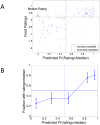Neural Activity Reveals Preferences Without Choices
- PMID: 25729468
- PMCID: PMC4339868
- DOI: 10.1257/mic.6.2.1
Neural Activity Reveals Preferences Without Choices
Abstract
We investigate the feasibility of inferring the choices people would make (if given the opportunity) based on their neural responses to the pertinent prospects when they are not engaged in actual decision making. The ability to make such inferences is of potential value when choice data are unavailable, or limited in ways that render standard methods of estimating choice mappings problematic. We formulate prediction models relating choices to "non-choice" neural responses and use them to predict out-of-sample choices for new items and for new groups of individuals. The predictions are sufficiently accurate to establish the feasibility of our approach.
Figures





References
-
- Bateman Ian J, Carson Richard T, Day Brett, Hanemann Michael, Hanley Nick, Hett Tannis, Jones-Lee Michael, Loomes Graham, Mourato Susana, Ozdemiroglu Ece, Pearce David W, Sugden Robert, Swanson John. Economic Valuation with Stated Preference Techniques: A Manual. Northampton: Edward Elgar; 2002.
-
- Belloni Alexandre, Chernozhukov Viktor, Hansen Christian. Inference Methods for High-Dimensional Sparse Econometric Models. Advances in Economics and Econometrics; 10th World Congress of the Econometric Society.2011.
-
- Bernheim B Douglas. On the Potential of Neuroeconomics: A Critical (but Hopeful) Appraisal. American Economic Journal: Microeconomics. 2009;1:1–41.
-
- Blackburn McKinley, Harrison Glenn W, Rutstrom E Elisabet. Statistical Bias Functions and Informative Hypothetical Surveys. American Journal of Agricultural Economics. 1994;76:1084–88.
Grants and funding
LinkOut - more resources
Full Text Sources
Other Literature Sources
